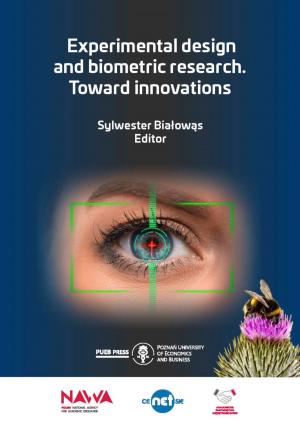Redakcja naukowa
Sylwester Białowąs
Experimental design and biometric research. Toward innovations
Dostępność i zakup
Wersja elektroniczna(IBUK)Wersja elektroniczna
(CEEOL)
*Kliknięcie przycisku powoduje przeniesienie na zewnętrzną platformę udostępniania lub sprzedaży.
Książka jest dostępna w subskrypcjach bibliotecznych: Ibuk Libra i EBSCO.
Białowąs, S. (red.). (2021). Experimental design and biometric research. Toward innovations. Wydawnictwo Uniwersytetu Ekonomicznego w Poznaniu. https://doi.org/10.18559/978-83-8211-079-1
This e-book aims to present the most critical aspects of knowledge about using experiments in economics and practical tools for using them. The topic is extended to the more advanced and increasing in popularity area of biometric research.
The book is divided into three parts mirroring experimentation. The first part provides theoretical background and tips about organising own research. The chapter is concluded with a guide focused on writing a research report in APA style. This part includes an example of the actual research report.
The next part has two chapters, and both are guided tours allowing to plan and conduct eye-tracking research and electrodermal activity research (EDA). The chapters contain details about preparing experiments, conducting them, using the dedicated software to analyse collected data and interpreting the default charts.
The last part is devoted to the data analysis and is universal, goes beyond the biometric experiments. There are three chapters in this part covering the standard procedures used in the analysis of experiments. The first part includes tests for one hypothesis: parametric t-test and One-Way ANOVA and non-parametric siblings: Mann Whitney U test and Kruskal-Wallis test. The next part describes tests allowing testing more hypotheses: ANOVA without repetition and ANOVA with repetitions. Furthermore, the last chapter deals with dependent samples, which are a popular approach in experiments. This part describes the dependent sample t-test and Wilcoxon test. The effect sizes calculations are included; each test is shown with screenshots from SPSS and some additional screenshots from Excel. This approach allows following the procedure step by step. The examples help easily understand procedures and interpretations; they were chosen from areas of sustainability and innovations to match the general idea of the e-books series prepared within the CENETSIE program.
The book contains texts that can be useful in the teaching process. It can be helpful in graduate programs in economics and business schools. Programs of doctoral schools cab benefit from this book as well.
Preface
PART I
PLANNING AN EXPERIMENT
Sylwester Białowąs, Atanaska Reshetkova, Adrianna Szyszka
1. EXPERIMENTAL DESIGN
1.1. Introduction to the experimental method
1.1.1. The definition of experiment
1.1.2. Experiments and other methods of scientific research
1.1.3. Research design: type of data
1.1.4. Application in economics and management
1.2. Key concepts prior to planning an experiment
1.2.1. Causality
1.2.2. Independent and dependent variables
1.2.3. Experimental and control groups
1.2.4. Selecting research participants
1.3. Planning an experiment
1.3.1. Defining the problem and research questions
1.3.2. Null and alternative hypotheses as well as significance
1.3.3. Data presentation and report structure (APA standards)
1.4. Types of experimental research design
1.4.1. Within-subjects and between-subjects experimental designs
1.4.2. Different types of experimental designs
1.5. Conducting experiments
1.5.1. Internal and external validity
1.5.2. Experimental errors (threats to validity)
1.5.3. Ethics in experimentation
PART II
CONDUCTING BIOMETRIC RESEARCH
Sylwester Białowąs, Adrianna Szyszka
1. EYE-TRACKING RESEARCH
1.1. Eye-tracking—what it is and how it works
1.2. What can be examined using eye-tracking
1.3. How eye-tracking research is prepared
1.4. Visual activity testing rules
1.5. Before the experiment (proper usage of the equipment, calibration, recording)
1.6. Data preparation (adding reference image, adjusting gaze points, adding areas of interests, dividing videos, groups)
1.7. Analysis using default charts
1.8. Exporting data for advanced analysis
Bartłomiej Pierański, Jakub Berčík
2. RESEARCH ON ELECTRODERMAL ACTIVITY
2.1. What is electrodermal activity and why consumers can be better understood by measuring it?
2.2. Types of electrodermal activity
2.3. Measurement of electrodermal activity
2.4. How to successfully conduct experiments on EDA (step-by-step guide)
2.4.1. Equipment preparation
2.4.2. Acquiring EDA data
2.4.3. Analysing EDA data
2.5. Case study—Perception of a humanoid robot
PART III
DATA ANALYSIS
Sylwester Białowąs, Blaženka Knežević, Adrianna Szyszka, Berislav Žmuk
1. INDEPENDENT SAMPLES—SINGLE HYPOTHESIS TESTING
1.1. Independent samples—t-test
1.2. Mann-Whitney U test
1.3. One-way analysis of variance (ANOVA)
1.4. Kruskal-Wallis H test
Blaženka Knežević, Berislav Žmuk
2. INDEPENDENT SAMPLES—MORE HYPOTHESES TESTING
2.1. Two-way analysis of variance (ANOVA) without replication
2.2. Two-way analysis of variance (ANOVA) with replication
Sylwester Białowąs, Adrianna Szyszka
3. DEPENDENT SAMPLES—SINGLE HYPOTHESIS TESTING
3.1. The paired samples t-test
3.2. Wilcoxon signed-rank test
Rozdziały:

Metadane
- ISBN: 978-83-8211-079-1
- DOI: 10.18559/978-83-8211-079-1
- Wydanie: I
- Rok wydania: 2021
- Rok premiery: 2021
- Strony: 163
- Wersja papierowa:
- Wersja elektroniczna: pdf
- Format:
- Licencja: open access
scientific research, innovations, experiments, eye-tracking, sustainability, sustainable development
ostatni tydzień: 18
ostatnie 3 miesiące: 174
ogółem: 1892



 Pełna wersja do pobrania (pdf)
Pełna wersja do pobrania (pdf)